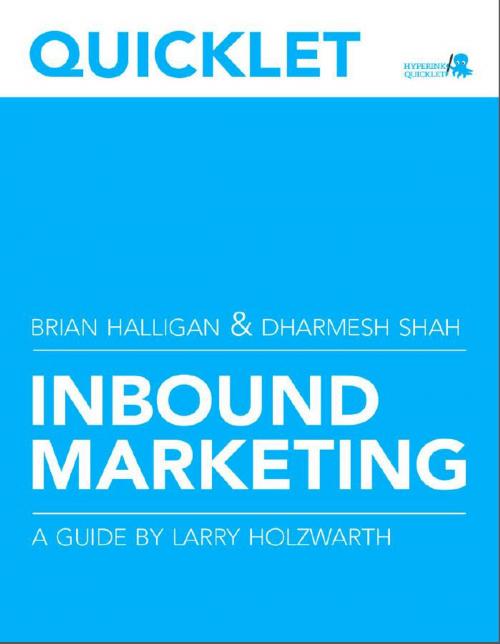Quicklet on Brian Halligan and Dharmesh Shah's Inbound Marketing: Get Found Using Google, Social Media, and Blogs (CliffsNotes-like Summary & Analysis)
Nonfiction, Reference & Language, Study Aids, Book Notes, Art & Architecture, General Art| Author: | Larry Holzwarth | ISBN: | 9781614646723 |
| Publisher: | Hyperink | Publication: | July 30, 2012 |
| Imprint: | Hyperink | Language: | English |
| Author: | Larry Holzwarth |
| ISBN: | 9781614646723 |
| Publisher: | Hyperink |
| Publication: | July 30, 2012 |
| Imprint: | Hyperink |
| Language: | English |
ABOUT THE BOOK
When it was released in the fall of 2009, The Boston Globe called Inbound Marketing: Getting Found Using Google, Social Media and Blogs, “...quite simply the best collection of practical, tactical advice I’ve seen to explain this important shift in marketing.” Which raises the question, “Which shift is that?”
According to Brian Halligan, one of the book's two authors, “People just don't listen to ads or read spam emails, and we don't pick up the phone if we don't know who it is. That kind of marketing is broken; The alternative is to have customers find the seller, rather than the seller, or marketer, interrupt potential customers with marketing materials and unsolicited calls. Inbound Marketing is all about how to do just that.
Authored by the co-founders of Hubspot, which sells software to accomplish the processes described within, Inbound Marketing reveals the practical steps to be taken to develop a new kind of marketing strategy, using blogs, Facebook pages, Tweets and interactive Web sites to help potential customers field a marketing venture, rather than resorting to the traditional methods of high cost multi-media advertising, direct mail, email, or cold calling by a sales force.
EXCERPT FROM THE BOOK
Defining your approach is an essential step in developing your inbound marketing strategy.
The Grateful Dead are used as an example of developing first a niche market and then an inbound marketing strategy to build their brand. For those unfamiliar, the Dead made records that sold poorly, yet attracted a singularly faithful audience. Brian Halligan is a self proclaimed Grateful Dead fan. He uses them as an example of using inbound marketing, allowing their fans to come to them and eventually becoming “one of the highest grossing bands of all time.”
The use of the Grateful Dead as an example of a successful inbound marketing strategy is somewhat fallacious, the sort of anecdote expected in a seminar to inject a lighthearted moment. It is akin to Yogi Berra’s comment about making the right mistake. The Grateful Dead simply made records that did not sell particularly well outside of their own genre, though their fans were devoted followers. As an example of what can happen when devoted fans spread the word amongst themselves, leading to increased followers their example can be instructive, but the implication that they developed and implemented an effective inbound marketing strategy is misleading.
They did not give records away. They charged competitive prices for their performances. They often performed at large music festivals. They followed the traditional methods of the day. They achieved success, though not as one of the highest grossing acts of all time, due to longevity and continuous work. There is a significant difference between a successful strategy and a fortuitous result. One does not necessarily follow the other.
Part Two Get Found By Prospects
Chapter Four. Get Found By Prospects
In addition to a remarkable value proposition one must create remarkable content about one’s products and services. Remarkable content attracts to your web site, which in turn attracts the notice of search engines, indicating your site is worthy of increased attention via keywords. Remarkable content also moves quickly across the social media sites. A remarkable blog will spread quickly across the social media relevant to your product or service and draw more attention, more site visits and potentially more customers.
It is therefore obvious that there is a need to create remarkable content on a continuing basis...
Buy the book to continue reading!
Follow @hyperink on Twitter!
Visit us at www.facebook.com/hyperink!
Go to www.hyperink.com to join our newsletter and get awesome freebies!
ABOUT THE BOOK
When it was released in the fall of 2009, The Boston Globe called Inbound Marketing: Getting Found Using Google, Social Media and Blogs, “...quite simply the best collection of practical, tactical advice I’ve seen to explain this important shift in marketing.” Which raises the question, “Which shift is that?”
According to Brian Halligan, one of the book's two authors, “People just don't listen to ads or read spam emails, and we don't pick up the phone if we don't know who it is. That kind of marketing is broken; The alternative is to have customers find the seller, rather than the seller, or marketer, interrupt potential customers with marketing materials and unsolicited calls. Inbound Marketing is all about how to do just that.
Authored by the co-founders of Hubspot, which sells software to accomplish the processes described within, Inbound Marketing reveals the practical steps to be taken to develop a new kind of marketing strategy, using blogs, Facebook pages, Tweets and interactive Web sites to help potential customers field a marketing venture, rather than resorting to the traditional methods of high cost multi-media advertising, direct mail, email, or cold calling by a sales force.
EXCERPT FROM THE BOOK
Defining your approach is an essential step in developing your inbound marketing strategy.
The Grateful Dead are used as an example of developing first a niche market and then an inbound marketing strategy to build their brand. For those unfamiliar, the Dead made records that sold poorly, yet attracted a singularly faithful audience. Brian Halligan is a self proclaimed Grateful Dead fan. He uses them as an example of using inbound marketing, allowing their fans to come to them and eventually becoming “one of the highest grossing bands of all time.”
The use of the Grateful Dead as an example of a successful inbound marketing strategy is somewhat fallacious, the sort of anecdote expected in a seminar to inject a lighthearted moment. It is akin to Yogi Berra’s comment about making the right mistake. The Grateful Dead simply made records that did not sell particularly well outside of their own genre, though their fans were devoted followers. As an example of what can happen when devoted fans spread the word amongst themselves, leading to increased followers their example can be instructive, but the implication that they developed and implemented an effective inbound marketing strategy is misleading.
They did not give records away. They charged competitive prices for their performances. They often performed at large music festivals. They followed the traditional methods of the day. They achieved success, though not as one of the highest grossing acts of all time, due to longevity and continuous work. There is a significant difference between a successful strategy and a fortuitous result. One does not necessarily follow the other.
Part Two Get Found By Prospects
Chapter Four. Get Found By Prospects
In addition to a remarkable value proposition one must create remarkable content about one’s products and services. Remarkable content attracts to your web site, which in turn attracts the notice of search engines, indicating your site is worthy of increased attention via keywords. Remarkable content also moves quickly across the social media sites. A remarkable blog will spread quickly across the social media relevant to your product or service and draw more attention, more site visits and potentially more customers.
It is therefore obvious that there is a need to create remarkable content on a continuing basis...
Buy the book to continue reading!
Follow @hyperink on Twitter!
Visit us at www.facebook.com/hyperink!
Go to www.hyperink.com to join our newsletter and get awesome freebies!















